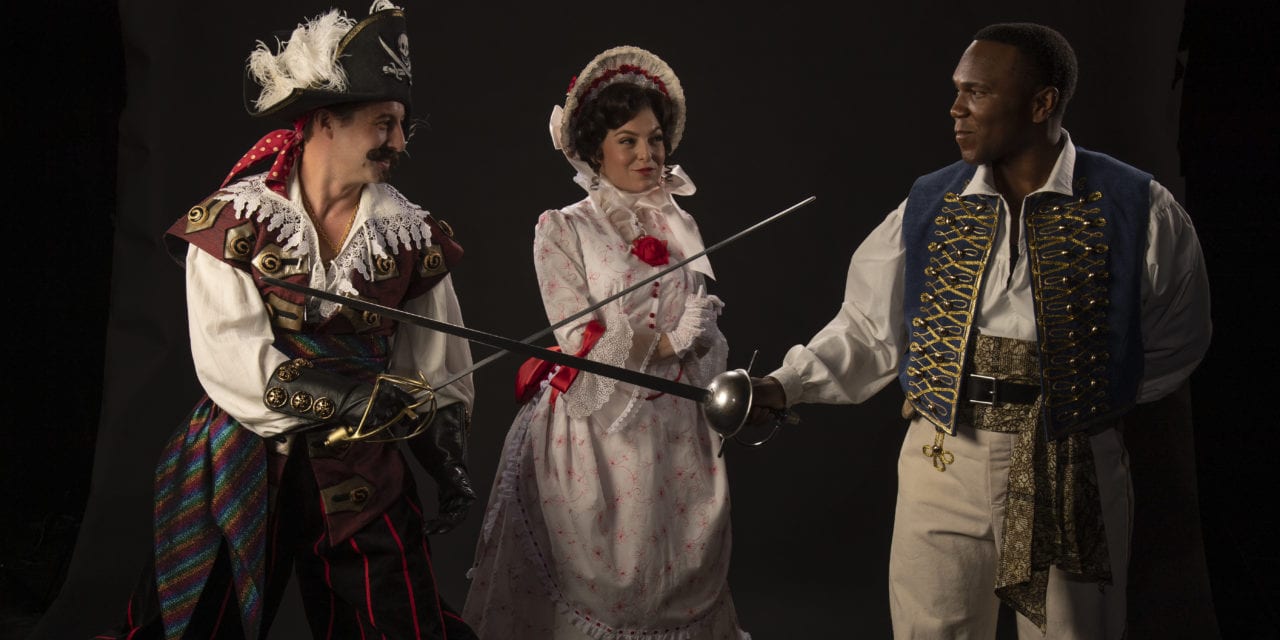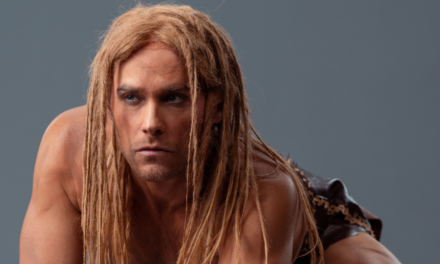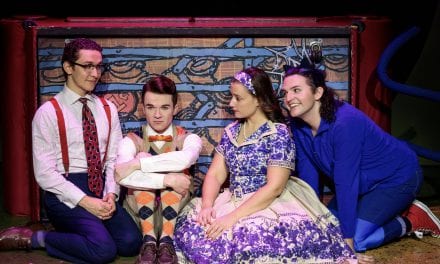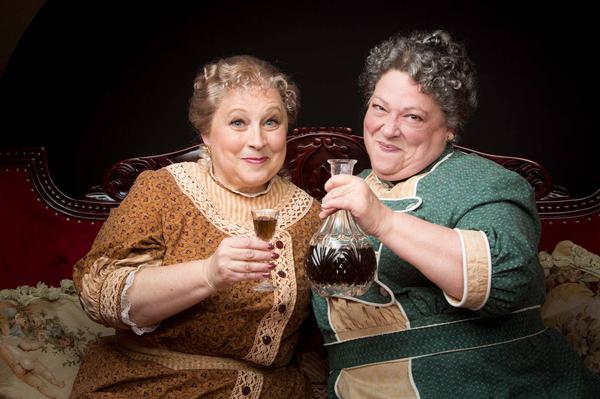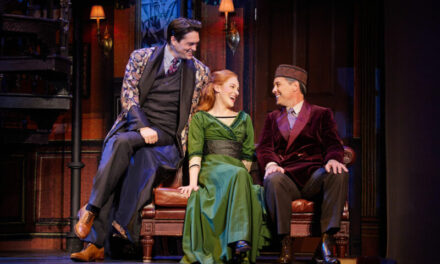CEDAR CITY — The Pirates of Penzance is a victim of its popularity. With its creators long dead and the play in the public domain, it is often an economical selection for amateur groups looking to mount a musical. However, the play’s score is vocally demanding, and the show is outside the musical theatre tradition, making it a challenge for amateurs. As a result, most people see lackluster productions of The Pirates of Penzance, and Gilbert and Sullivan‘s brilliance is often obscured. The Utah Shakespeare Festival must-see production of The Pirates of Penzance bucks this trend and does much to show the audience why this show’s reputation has endured for nearly 150 years.

Show closes October 9, 2021.
As The Pirates of Penzance opens, young Frederic is preparing to leave his apprenticeship with a band of pirates after turning 21. Being a thoroughly British young man, he has a strong sense of duty and propriety, which means that he is willing to participate in the pirates’ escapades — but when he is free from them, he plans to turn them into the authorities. The celebrations are interrupted by the arrival of a band of sisters who are the daughter of Major-General Stanley. Frederick falls in love with one of them, Mabel, but things get complicated when the pirates attack Mabel’s father.
The direction from Cassie Abate is brimming with whimsy. Abate understands that The Pirates of Penzance is supposed to be a lighthearted entertainment, and she packed as much silliness as she could in every scene. Her addition of a tap dance battle to “When the Foeman Bares His Steel” was an absurdist surprise, and embracing the melodrama of “Poor Wand’ring One” heightened the song’s humor.

Jalon Matthews (left) as Frederic and Cecilia Iole as Mabel in the Utah Shakespeare Festival’s 2021 production of The Pirates of Penzance. (Photo by Karl Hugh. Copyright Utah Shakespeare Festival 2021.)
But Abate’s skill as a director is dwarfed by her talent as a choreographer for this play. While watching The Pirates of Penzance, I found myself eagerly waiting for the next dance number because every dance in The Pirates of Penzance was a delight. The dainty steps and use of parasols in “Climbing Over Rocky Mountain” showed the sisters as refined and civilized, a contrast to the rough pirates in the preceding scene. In the famous “I Am the Very Model of a Modern Major-General,” the cast’s rapid, brisk movements matched the song’s militaristic themes and rhythm (and was just plain fun, to boot). And “When You Had Left Our Pirate Fold” had a giddy energy that is an unexpected surprise in a show that is nearly 150 years old.
Leading this production is Jalon Matthews as Frederic. Matthews plays Frederic with disarming sincerity, and it is believable that this naïve young man could offend a group of women by prefacing an overture of love with the phrase “However plain you be.” Matthews also plays the puppy love of “Poor Wand’ring One” without falling into cliché or losing the humor of the moment. Finally, in Matthews’s portrayal, Frederic becomes more dashing and daring as the play progresses, and Matthews has the charm needed to be an engaging romantic lead.

Cecilia Iole as Mabel in the Utah Shakespeare Festival’s 2021 production of The Pirates of Penzance. (Photo by Karl Hugh. Copyright Utah Shakespeare Festival 2021.)
Cecilia Iole puts the “opera” in “operetta” when her strong soprano voice sings the role of Mabel. “Oh, Dry the Glistening Tear,” “Stay, Frederic, Stay!”, and “Poor Wand’ring One” all benefited from Iole’s firm vocal control while singing the score’s challenging high notes. Iole’s acting was no less impressive; she makes Mabel exude both elegance and fortitude, whether it is when prancing around with her sisters, or confronting the pirate king.
Rhett Guter returns to the Festival in the role of the Pirate King, and his performance is a triumph. Guter swaggers about the stage, comically preening in his high, black boots and open white shirt. His resonant tenor voice is a luscious contribution to the first act finale, “Oh, Men of Dark and Dismal Fate.” Guter is most engrossing, though, while dancing, whether it is tap, ballet, or traditional musical theatre. Guter sets a high standard for the dancing in the production, and he singlehandedly elevates the show’s choreography to high art.
While I adored the leads in this show, the actors The Pirates of Penzance are all a “rollicking band.” Without exception, every cast member created a stellar performance. As Major-General Stanley, Richard R. Henry was comically bombastic, and his rendition of the famous song, “I Am the Very Model of a Modern Major-General” fulfilled its humor potential. Marlene Montes played Ruth with gusto, especially in the second act when Abate made the character rejoin the pirate band as a full-fledged pirate. Montes’s energy and exuberance in the role was one of the production’s most memorable aspects.

Rhett Guter as The Pirate King in the Utah Shakespeare Festival’s 2021 production of The Pirates of Penzance. (Photo by Karl Hugh. Copyright Utah Shakespeare Festival 2021.)
I practically fell in love with the sisters in this production (played by Lena Conatser, Daria Pilar Redus, Bailey Blaise, Tafadzwa Diener, Sophia Guerrero, and Amara Webb). Each assigned a different accent color by costumer Bill Black, the six formed a rainbow of color and vivacity that formed the backbone of the ensemble. Moreover, each sister had a unique personality, and I enjoyed watching the bossy sister, the gregarious sister, the kindhearted sister, and others throughout the play.
The centerpiece of Jo Winiarski‘s set was two sets of movable stone stairs that provided levels for the action and an upstage backdrop consisting of white sails. These sails matched the show’s nautical setting and also were a canvas for William C. Kirkham‘s gorgeous, saturated lighting. Winiarski also created a false wooden proscenium that functioned as a literal frame for Abate’s endlessly pleasing stage pictures.
The only drawbacks of these productions concerned the sound. In several ensemble songs, the diction was not crisp enough for me to understand important lyrics. Additionally, the tap dancing was often so loud that it overpowered the vocals. These problems were minor annoyances, though, and they did little to diminish my overall enjoyment and respect for this production.
There are so many reasons to The Pirates of Penzance at the Utah Shakespeare Festival. See it for the humor. See it for the athletic dancing. See it for the vocal power. See it for the lovely costumes, set, and lighting. See it to watch Gilbert and Sullivan’s work at its best. Just see it.

This review is generously supported by a grant from the Utah Division of Arts and Museums.

